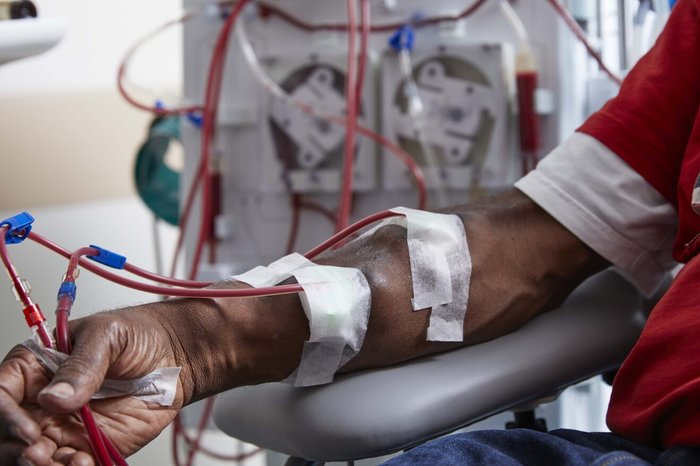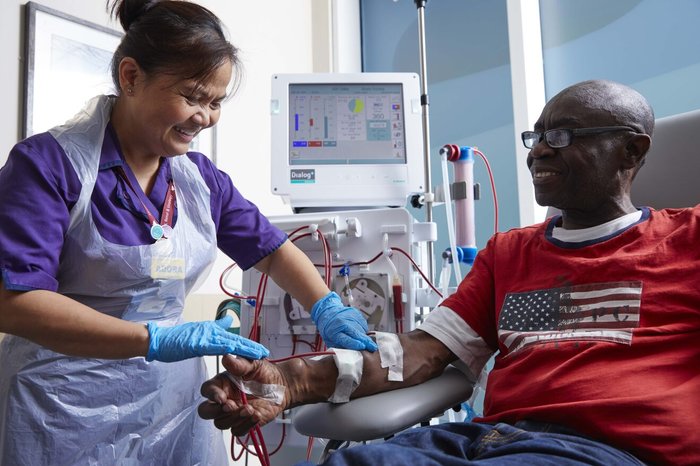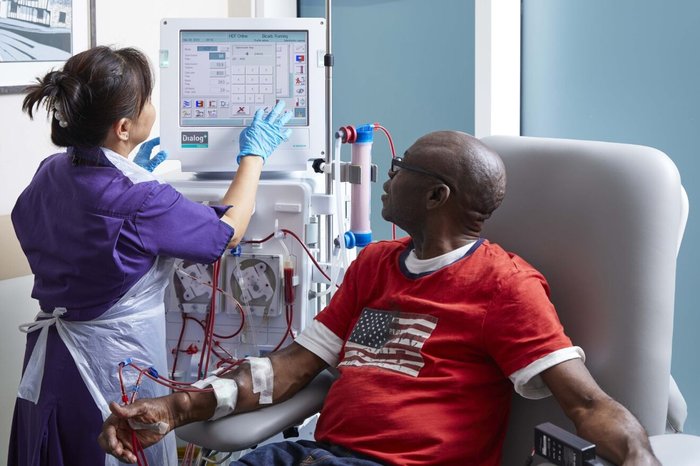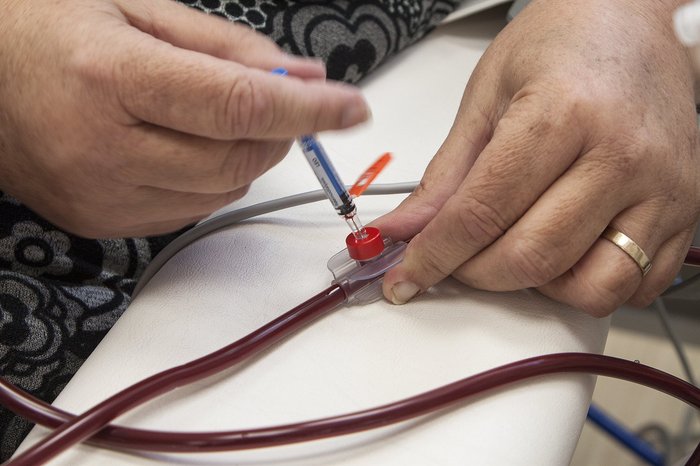If you have CKD (chronic kidney disease) and have decided to receive haemodialysis (HD), you will need to have special access created to your veins. UK guidelines recommend that you have an arteriovenous fistula (AVF) created to allow this.
What is a fistula
A fistula is a special connection that is made by joining a vein onto an artery, usually in your arm. This creates a large, robust blood vessel that can be needled regularly for use during haemodialysis.
Why is it necessary?
Haemodialysis works by taking blood from your body and 'cleaning it' through a machine to remove the toxins. Blood is taken out of your body and run through a filter before being returned to you. Toxins move from your blood into dialysis fluid and the dialysis fluid is then drained. The fistula provides a reliable way of processing high volumes of blood for haemodialysis.

How is a fistula created?
Your fistula is usually created during a small operation that is usually done under a local anaesthetic, which makes your skin go numb so you do not feel anything. Some people may need a general anaesthetic where you go to sleep. This would be the case if a bigger operation is required or you are unlikely to tolerate local anaesthetic.
Your fistula will usually be created in your non-dominant arm - (the arm you don't write with) so in your left arm if you are right-handed. It is usually created either at the level of your wrist or in the elbow region.
The surgeon will make a small cut in the skin. The artery, which carries blood from the heart, and the vein, which carries blood back to the heart, will be joined together by making a small opening between them. This will allow some of the blood in the artery to be redirected to the vein. Stitches are used to close the cut in the skin. These are usually dissolvable and will start to fade away by themselves after about 10 days. This operation usually lasts about an hour.
Will it leave a scar?
Yes. The surgery will usually leave a scar. This is because a cut is made to make the fistula. Over time the scar will normally fade in appearance. The scar is usually no longer than 4cm.
When is the best time to have it made?
Ideally your kidney team will plan the formation of a fistula with you in advance of starting dialysis. This allows time for the fistula to develop so it is ready to use when you need dialysis. The longer a fistula has to develop before it is used for dialysis, the better it performs and the longer it lasts. It is therefore recommended that a fistula be created approximately six months before you need to start dialysis.

Before you are given a date for your operation, you will see a surgeon in the outpatient clinic. The surgeon will explain the proposed operation to you. They may arrange further investigations to help with the decision of the kind of fistula you need to have. These investigations usually include an ultrasound scan of your arm to look at the size of the arteries and veins.
When will my fistula be ready?
Over time, the vein becomes bigger, and its walls become thicker and stronger due to the increased blood flowing through it. We call this ‘maturing’. Usually, it takes around 6 to 8 weeks after it has been created before it is ready to be used. Your kidney team will keep checking your fistula and will let you know when it is ready to be used.
You will also be taught what your fistula should feel and sound like so that you can check it yourself and make sure it is continuously working. This can be really important, as you may be the first person to notice something is not right with the fistula. You can flag this to the access nurses in a timely fashion so hopefully your fistula can be preserved for continued use.
If you need to start haemodialysis before your fistula has matured, you can have it through a dialysis line in your neck. This can be used immediately.
What are the benefits of having a fistula?

A working fistula is the best form of long-term access for haemodialysis. The alternative to having a fistula is to have a haemodialysis line. Although these can provide good-quality dialysis, studies have shown that having a fistula has advantages if they can be formed.
A fistula usually allows you to have better, more efficient dialysis than a line, because the blood can flow out quicker, so you get more dialysis in your session. This is important for long-term health and survival.
Over time dialysis lines can damage the vessels where they are placed, and this can mean that it can be difficult not only to have other lines but also to make fistulas in the future.
A fistula is internal so does not involve external tubes or artificial material in the body. The risk of infection is lower and you can swim, have a bath or shower, and take part in water sports with a fistula.
Not all patients will be able to have a fistula; this may be because the veins in your arms are too small. In these situations, there are a number of options that can include the placement of an 'artificial vein', called a graft. If this is something that you are likely to need your clinical team should discuss this with you.
What are the risks when having a fistula formed?
Fistula formation is generally safe and straightforward. However, with any procedure, there are some possible risks and complications. It is important that you are aware of these but remember, this will happen to a minority of patients.
Clotting of fistula

If your fistula clots, this means that the blood stops flowing through it. It is important to contract the hospital as soon as you notice any change as often the clot can be removed. Sometimes the clot may not be able to be removed and you may need to have a different type of access for dialysis, such as another fistula in the other arm.
Steal syndrome
When the fistula is formed, it changes the normal blood flow through the arteries to the smaller vessels in the hand. If a large amount of blood passes directly from the artery into the vein this can lead to a reduced blood supply to the hand and fingers. This can result in cold, numb fingers, which may be painful. It can also reduce the blood supply to the nerves to the hand, which can reduce the strength in the hand.
This happens in less than 10% of cases. The risk changes depending on the type of fistula and is more common if you have diabetes or a disease of the blood vessels. In approximately 3% of people, the surgeon has to perform another operation to reverse the fistula and improve the blood supply to the affected hand.
Infection
The wound can become infected. This will require antibiotics. In some people, the area where the fistula is made can become infected and this is serious, usually requiring injections of antibiotics.
Swelling of the arm

Most people will not experience a large amount of swelling after the operation. Swelling is most common when the fistula operation is not a simple operation or when a graft is used. It is usually treated by raising the arm to above the level of the heart and the surgeon may recommend exercising the fingers to help reduce the swelling.
Numbness over the surface of the thumb
Sometimes the surgery, especially at the level of the wrist, can lead to bruising of the nerve during surgery. This can lead to an area over the thumb feeling numb. It usually recovers over the next few weeks.
Is there anything I should do after the operation?
Fistula exercises can help the fistula to develop. Your team will be able to advise you on these exercises, but they should only begin after the swelling has gone down and the stitches have healed. They should continue until the fistula has matured enough to be used. These usually involve squeezing a stress ball in your hand.
What does it feel like when the fistula is used?
In the haemodialysis unit, the nurse will give you some local anaesthetic cream to apply to your fistula to help to numb the area. The nurse will then insert two needles into your fistula – one at each end – each time you have dialysis. One needle takes the blood out and the other puts the filtered blood back in. The needles are removed when your dialysis session has finished. You may feel a stinging sensation for a few seconds as the needle goes in, but it should not be painful.
Tubes are attached to the needles and connected to the dialysis machine. Your blood flows out of your fistula, through the tubing to the dialysis machine where it is cleaned before going back into your body via the other end of your fistula.
When the fistula is first used, the nurses may use smaller needles or one needle as you get used to it being used. It is not uncommon to have bruising when the fistula is first used but this becomes less common as the fistula is used more frequently.
How can I take care of my fistula?
- Keep it clean – infections are rare but can still happen. Wash your arm every day and always wash it before dialysis.
- Keep it clear – do not wear a watch or tight clothing on your fistula arm. Try not to sleep on that side of your body and avoid having your blood pressure or blood tests taken from that arm.
- Check it every day – your kidney team will show you how to check for a pulse or vibration through your fistula (called a thrill). If you don't feel this, contact your kidney team straight away as the fistula may be blocked.
- Never have blood pressure or blood samples taken from your fistula arm – this will increase the risk of damage to the fistula and of the fistula clotting.
- Avoid tight clothing over the fistula – this may reduce the blood flow to the fistula and take care when lifting heavy objects that put direct pressure on the fistula.
How can I tell if something is wrong with my fistula?
- Check for signs of infection like redness and swelling and contact your kidney team if your fistula feels hot, swollen or is causing you pain. These may be signs of infection and should be treated straight away.
- Bleeding from your fistula when you are not on haemodialysis is very rare. However, if it does happen you should get help immediately. Put pressure on the wound, call for help from family, friends or neighbours and call 999 for an ambulance.
- Bruising can happen if you move your arm too much during haemodialysis, causing the needle to shift and blood to leak into the surrounding tissue. It can be uncomfortable but is not dangerous if it is noticed quickly and the needle is re-positioned.
Seek medical help if:
- your fistula is red, hot or swollen.
- your fistula is no longer buzzing
- your fistula is bleeding
- your fingers become cold, painful or the strength in your fingers is reduced.